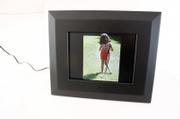The reign of the traditional picture frame or photo album may well be over.
Seven or eight years ago, digital picture frames cost as much as $700. But, like most new technological gadgets, the cost has dropped over time. So much so that it's pretty safe to say the age of the digital frame has arrived.
A digital picture frame looks much like a regular picture frame; it is roughly the same shape and size. However, the digital picture frame has an LCD screen (like a computer screen), which displays a slideshow of images.
Depending on the digital frame you buy, you might have to connect it to your computer and download the photos from there. With other digital frames, you simply pop in the memory card from your camera.
Austin Pittman, district manager of Bedford Camera & Video in North Little Rock, said the store has been selling digital picture frames for about five years. But it wasn't until last Christmas that he noticed they were becoming hot sellers.
Pittman attributes the growing popularity of digital picture frames to a couple of factors. Digital cameras are allowing people to take more pictures than ever before. For awhile, digital camera owners were making fewer prints, but the trend has started to reverse for one simple reason: People like seeing their pictures displayed around the house and the workplace, not just on their computer screens. Digital picture frames have plenty of memory, like a computer, and look great on a wall, just like a traditional picture frame.
"The major benefit is that with digital frames you can have one image on there or 500," Pittman said. "It allows you to show a lot more pictures in a lot less space."
When choosing a digital picture frame, Pittman said there are a couple factors to consider.
Price: Pittman said that consumers can now get a digital picture frame for between $80 and $300. How much you pay will largely depend on the size of the display screen.
Size: The screens range from about 4 to 12 inches corner-to-corner. Pittman said resolution varies only slightly among different screen sizes and is almost unnoticeable unless you select one of the larger frames. So choosing the right frame for you simply depends on how big you want to display your photos and how much desk or wall space you want to use.
Memory: Some digital picture frames have internal memory, others have memory card slots, and some have both. Pittman said he recommends choosing one with a memory card slot. The frames don't come with memory cards, but almost everyone who owns a digital camera has one anyway. Plus, you can switch out pictures without having to download them directly from your computer. Keep in mind though, that some frames accept only certain types of memory cards and require that you leave the memory card in the frame in order to view the pictures. The cost of an additional memory card might play into your decision.
Audio and video capabilities: If you feel like going to the next level of digital picture frame creativity, a few of the models have options for embellishing your digital slide show with MP3s or video.
